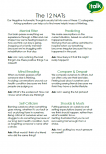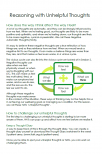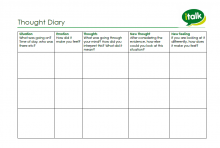Patient Area
5. Managing Thoughts
Here you'll find all the worksheets and information you'll need to accompany your learning for Session 5 of our Building Resilience with Long-Term Physical Health Conditions webinars.
What we learned this week
How our thoughts can reflect our emotions

This week we looked at the 'thoughts' part of our 5 areas model, and the close links between our thoughts and feelings.
We explored how our minds can be very busy, and depending on how we feel emotionally, we might find negative automatic thoughts pop up without warning. These automatic thoughts are often linked to our emotions and may not reflect what we actually think.
At other times, our surface thoughts might be connected to our deeper beliefs (core beliefs), a bit like an iceberg, and so they might be more painful or upsetting for us.
This week we learned how to spot these automatic thoughts and challenge them, so that we can respond to them in more helpful ways.
How keeping a thought diary can help
We suggested keeping a thought diary to start to notice the links between our thoughts, feelings and actions.
It's not always easy to notice the links in the moment, but later on when the emotions have passed, we can reflect on whether we think about the situation differently, and whether that changes the actions we would choose.
Resource: Thought Diary Worksheet
How to spot Negative Automatic Thoughts
We learned that Negative Automatic Thoughts (we'll call them NATs), are a natural part of life. They tend to fall into 12 categories, and we all experience them.
Because they're automatic, we can't stop them from popping up, but once we get familiar with how to spot them, we can decide whether that's what we really think, or whether we would choose to think about things in a more helpful way.
Resource: Video guide to spotting the 12 types of NAT
How to challenge our NATs
We introduced a technique that can help us to challenge our NATs, and find a more helpful way of thinking about things.
Reasoning with your thoughts
- Write down the thought, and think about why it's important to you. Is there a 'rule for living' or 'core belief' behind this thought?
- Then, write down the type or types of NAT it is. Tip: One thought can be a few types of NAT!
- Use the guide to 12 Types of NAT to ask yourself questions and think it through.
- Aim to find a new thought that is still true to what's important to you, but is more helpful and more reasonable.
Resources:
- Thought challenging guide
- Guide to the 12 types of NAT and how to challenge them
Actions
These are our suggested ways to put into practice what you've learned this week:
- Try keeping a thought diary
Tip: Use the video guide to spot NATs
- Try using the thought challenging technique
Tip: It can be helpful to start with a thought that you don't feel as strongly about. Once you're familiar with the technique, it will feel easier to use it for the more difficult NATs.
Downloads
Thought Diary (Doc)
Download to print, complete digitally or copy onto paper.
Click here to download
 Menu
Menu





